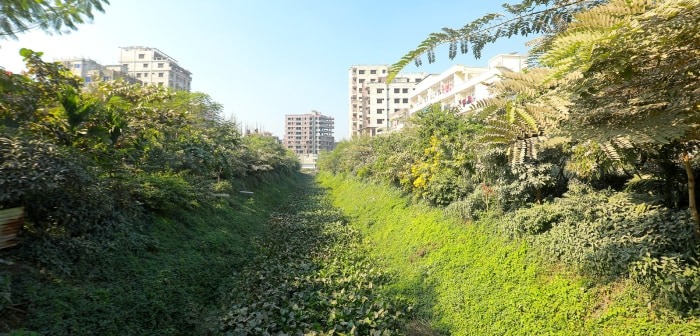
Urban environments often intensify a range of environmental challenges, particularly in rapidly growing, underdeveloped megacities such as Dhaka. Heavy rains frequently overwhelm the city’s drainage systems, causing waterlogging and disruptions to daily life. This situation also heightens the risk of infectious diseases, including waterborne and vector-borne pathogens such as diarrhoea, malaria, and dengue. In summer, the combination of persistently high temperatures and densely packed buildings creates a phenomenon known as the urban heat island effect, where cities become considerably hotter than surrounding rural areas. The sweltering heat makes living conditions especially harsh in informal settlements, where 20% of the population resides. Overcrowding and poor ventilation increase vulnerability to heat stress and potentially life-threatening heatstroke. Meanwhile, unchecked industrial growth, traffic emissions, and poor waste management have led to severe air, soil, and water pollution — exposing residents to respiratory illnesses, cognitive deficits, premature mortality, and other ailments with long-term public health consequences.
Addressing these environmental challenges requires significant investments in infrastructure, technology, and ongoing maintenance. For a city like Dhaka, where resources are often stretched thin, implementing these solutions can be time-consuming, disruptive, and financially burdensome. However, the cost of inaction –including increased healthcare costs, loss of quality of life, and reduced tourism and foreign investment—can be even higher.
In honour of Earth Day 2025, the Lautola Forest in Mohammadpur, Dhaka stands out as a remarkable example of environmental transformation, converting an urban blight into the city’s first human-made urban forest. Previously, the Ramchandrapur Canal in Lautola Bosila was illegally occupied by a truck terminal, with small auto repair shops cramped into every corner. The dangers of such encroachment were evident—pollution and waste contributing to environmental degradation. However, an ambitious urban forestry initiative spearheaded by Shakti Foundation, a leading national-level NGO, facilitated the removal of the illegal structures and the restoration of the canal into a lush green space now home to over 9,000 trees and plants of 72 varieties. Co-funded by HSBC Bank Bangladesh and supported by the local government, this project symbolises the power of public-private partnerships in combating Dhaka’s environmental challenges.
Since its establishment in 2022, the vegetation and soil system within Lautola Forest have been effectively absorbing runoff in the area. Runoff occurs when rainwater is unable to be absorbed into the ground due to saturated topsoil or the presence of impervious surfaces such as buildings and roads, causing the water to flow into rivers, lakes, or other waterways. This runoff often carries pollutants such as dirt, chemicals, and waste, which can degrade water quality. The nitrates, phosphates, sulphates, carbon, and heavy metals found in runoff are essential nutrients for vegetation. As a result, Lautola Forest has been contributing to improving the water quality of Lautola Bosila by absorbing and, in the process, filtering out these nutrients from the runoff.
Trees are arguably one of the most effective and cost-efficient strategies for mitigating and adapting to the urban heat island effect. Urban forests, especially those with a dense tree canopy like Lautola Forest, can help tackle this issue through natural cooling mechanisms. One primary process is evapotranspiration, where vegetation absorbs water through their roots and releases it into the atmosphere through their leaves, helping to lower the surrounding temperature. Further, the shade provided by tree canopies reduces direct sunlight on heat-absorbing surfaces such as roads and pavements. In Lautola Forest, it has been demonstrated that under calm wind conditions, surface temperature on concrete—one of the hottest materials in urban areas — is approximately 2.1°C higher than that on grass shaded by trees. While this may seem modest, even small temperature reductions in an urban landscape can provide relief from heat stress, improve labour productivity, and lower energy consumption and associated emissions.

